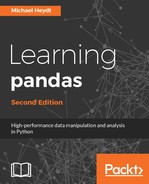The Series is the primary building block of pandas. It represents a one-dimensional array-like set of values of a single data type. It is often used to model zero or more measurements of a single variable. While it can appear like an array, a Series has an associated index that can be used to perform very efficient retrievals of values based upon labels.
A Series also performs automatic alignment of data between itself and other pandas objects. Alignment is a core feature of pandas where data is multiple pandas objects that are matched by label value before any operation is performed. This allows the simple application of operations without needing to explicitly code joins.
In this chapter, we will examine how to model measurements of a variable using a Series, including using an index to retrieve samples. This examination will include overviews of several patterns involved in index labeling, slicing and querying data, alignment, and re-indexing data.
Specifically, in this chapter we will cover the following topics:
- Creating a series using Python lists, dictionaries, NumPy functions, and scalar values
- Accessing the index and values properties of the Series
- Determining the size and shape of a Series object
- Specifying an index at the time of Series creation
- Using heads, tails, and takes to access values
- Value lookup by index label and position
- Slicing and common slicing patterns
- Alignment via index labels
- Performing Boolean selection
- Re-indexing a Series
- In-place modification of values
